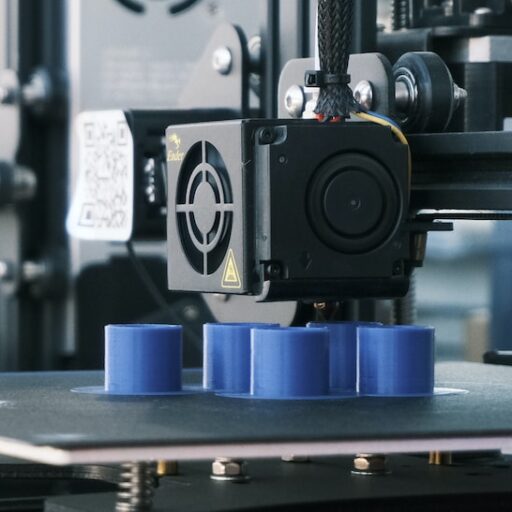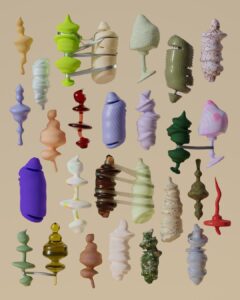Support our educational content for free when you purchase through links on our site. Learn more
Is 3D Printed Stuff Plastic? The Surprising Truth About 3D Printing Materials [2024] 🤯
You’re holding a cool gadget, a unique prototype, or a custom-designed trinket. It’s 3D printed, but what exactly is it made of? The answer might surprise you. 😮 While many people automatically think of plastic when it comes to 3D printing, the truth is far more complex and fascinating. This blog post delves into the world of 3D printing materials, exploring the most common plastics, their unique properties, and even delving into other materials used in this amazing technology. We’ll uncover the truth about 3D printed plastics, reveal their pros and cons, and even guide you through the world of alternative materials making their mark on the 3D printing scene. Ready to discover the magic behind those intricate 3D prints? Let’s dive in!
Quick Answer
- ✅ Most 3D printers use plastics as their primary material due to their versatility, affordability, and wide range of properties.
- ✅ It’s not just one type of plastic! ABS, PLA, PETG are all popular choices with unique advantages and disadvantages.
- ✅ 3D printing is evolving beyond plastics. Metal, wood, and even ceramics are making their way into the additive manufacturing world.
Looking for the perfect filament for your next 3D printing project?
- 👉 Shop [for 3D models & printable related queries:] Thingiverse
- 👉 Shop ABS Filament: Amazon | MatterHackers
- 👉 Shop PLA Filament: Amazon | MatterHackers
- 👉 Shop PETG Filament: Amazon | MatterHackers
Let’s explore the fascinating world of 3D printing materials!
Table of Contents
- Quick Tips and Facts
- The History of 3D Printing and Plastics
- The Most Common 3D Printing Plastics
- The Pros and Cons of 3D Printed Plastics
- 3D Printing with Other Materials
- The Future of 3D Printing and Plastics
- Conclusion
- Recommended Links
- FAQ
- Reference Links
Quick Tips and Facts
- ✅ Most common 3D printing materials are plastics. From the mundane to the extraordinary, plastics are the lifeblood of many 3D printing processes.
- ✅ Not all 3D printed plastics are created equal. They have varying strengths, weaknesses, and ideal use cases. Choose wisely, my friend!
- ✅ Think beyond the print! Consider the environmental impact of your chosen material and support structures. We only have one planet Earth! 🌏
- ✅ Safety first! 3D printing can create fumes. Proper ventilation is key for a happy and healthy printing experience.
Looking for some cool 3D Printable Objects? Check out our curated collection for inspiration! ✨
The History of 3D Printing and Plastics

The love story of 3D printing and plastics began in the early 1980s. The earliest 3D printing technologies, like stereolithography (SLA), used photosensitive polymers that solidified under UV light. This marked the beginning of what we now know as additive manufacturing. 🤯
Fun fact: Remember those awesome 3D Printable Objects from the 80s? Well, they were probably prototyped using early 3D printing technology with plastic polymers!
As technology evolved, so did the materials. Fused Deposition Modeling (FDM), now more commonly known as Fused Filament Fabrication (FFF), took center stage. FFF, the technology behind many desktop 3D printers today, utilizes thermoplastic filaments, heating and extruding them layer by layer to build objects.
The widespread adoption of FFF technology opened a floodgate for plastic innovation in the 3D printing world. The use of plastics like ABS (Acrylonitrile Butadiene Styrene) and PLA (Polylactic Acid) skyrocketed. Why? They were readily available, relatively affordable, and offered a good balance of strength and printability.
The journey didn’t stop there. Today, we see high-performance polymers like PEEK (polyether ether ketone) and PEKK (polyether ketone ketone) entering the arena. These materials boast exceptional strength and heat resistance, making them suitable for demanding applications in aerospace, automotive, and medical industries.
Want to dive deeper into the exciting world of 3D Printing Innovations? We’ve got you covered!
The Most Common 3D Printing Plastics
Let’s face it–navigating the world of 3D printing plastics can feel like wandering through a labyrinth. Fear not, intrepid explorer! We’re here to guide you through the most common options and help you conquer your next 3D printing quest. 🦸♂️🦸♀️
1. ABS (Acrylonitrile Butadiene Styrene)
Ah, ABS, the workhorse of the 3D printing world.
- Strengths: Durable, impact-resistant, can withstand higher temperatures, relatively inexpensive.
- Weaknesses: Can warp during printing, emits fumes, not biodegradable.
- Ideal for: Prototypes, functional parts, enclosures, toys.
Did you know? LEGO bricks are made from ABS plastic! 🤯
👉 CHECK PRICE on: Amazon | MatterHackers
2. PLA (Polylactic Acid)
The eco-conscious choice for many makers. 🌳
- Strengths: Biodegradable, easy to print, doesn’t require a heated bed, wide range of colors and blends available.
- Weaknesses: Lower heat resistance than ABS, can be brittle, susceptible to degradation from UV light.
- Ideal for: Decorative items, prototypes, low-stress parts, some educational applications.
Check out our in-depth guide on 3D Printing in Education to see how PLA is making waves!
👉 CHECK PRICE on: Amazon | MatterHackers
3. PETG (Polyethylene Terephthalate Glycol)
The best of both worlds?
- Strengths: Durable, impact-resistant, good chemical resistance, relatively easy to print.
- Weaknesses: Prone to stringing, can be hydroscopic (absorbs moisture, requiring proper storage).
- Ideal for: Functional prototypes, parts that need chemical resistance, water bottles, food containers (with proper food-safe post-processing).
Ever wonder how those intricate 3D Printable Objects are designed? Explore the fascinating world of 3D Design Software!
👉 CHECK PRICE on: Amazon | MatterHackers
Want more insider info on these popular plastics and the lowdown on other 3D printing materials? Keep reading – our journey into the world of 3D printing plastics is far from over! 🕵️♀️
Conclusion

So, is 3D printed stuff plastic? The answer, as you’ve seen, is yes, but with nuance. Most 3D printers rely on plastics as their primary material for their versatility, affordability, and wide range of properties. But within the world of 3D printing plastics, there’s incredible diversity – from workhorse materials like ABS to biodegradable options like PLA and high-performance polymers like PEEK.
The choice is yours, and it depends on what you’re printing and what kind of performance you need. Remember those cool 3D Printable Objects? They are often made of plastics, but that doesn’t mean they’re all the same!
The world of 3D printing is constantly evolving, and so are the plastics used. The future promises even more exciting materials with unique properties, pushing the boundaries of what’s possible with 3D printing. We’re excited to see what the future holds! 🚀
Remember to keep safety and sustainability in mind. Proper ventilation is key for a healthy printing environment, and we need to be mindful of the impact of plastic waste. But, with careful consideration, we can harness the power of 3D printing to create amazing things while minimizing our environmental footprint.
Recommended Links
👉 Shop [for 3D models & printable related queries:] Thingiverse
👉 Shop ABS Filament:
👉 Shop PLA Filament:
👉 Shop PETG Filament:
👉 Shop [for 3D models & printable related queries:] Thingiverse
Books on 3D Printing:
FAQ

Is 3D printed material plastic?
The simple answer is yes, but there are many different types of plastics used in 3D printing. Common materials include:
* Common 3D Printing Plastics:
- ABS: A durable and impact-resistant thermoplastic, often used for prototypes and functional parts.
- PLA: A biodegradable plastic, popular for its ease of printing and wide color selection.
- PETG: A strong and chemical-resistant thermoplastic, suitable for water bottles and food containers.
- Nylon: A strong and flexible thermoplastic, well-suited for mechanical parts.
* High Performance Plastics:
- PEEK: A high-performance polymer, boasting impressive heat resistance and strength.
- PEKK: Another high-performance polymer, known for its toughness and chemical resistance.
* Soluble Plastics:
- HIPS: Soluble in limonene, commonly used for support structures.
- PVA: Dissolves in water, also popular for support structures.
Read more about “What is 3D Printed? Unveiling the Magic of Additive Manufacturing … 🖨️”
Is 3D printing bad for the environment?
3D printing, like any other manufacturing process, can have environmental impacts. These impacts depend a lot on factors like energy consumption, material sourcing, waste management, and even the printing process itself.
* Pros and Cons of 3D Printing:
- Pros:
- Reduced waste: 3D printing creates less material waste compared to traditional manufacturing methods.
- On-demand production: Reduce transportation and warehousing needs.
- Cons:
- Energy consumption: The printing process itself requires electricity.
- Material sourcing: Ensure sustainable sourcing of materials, especially plastics.
- Plastic waste: Proper disposal of plastic parts and support materials is crucial.
Read more about “How Disruptive is 3D Printing Really? … 💥”
Are 3D printed homes plastic?
While there are 3D printed homes made of concrete, some are made using plastic materials.
* What Makes A 3D Printed Home?
- Extruded plastic: Using a robot arm for extrusion, similar to FDM, a 3D printed home can be created.
- Structural concrete: With large-scale 3D printing, concrete is used for creating complex shapes and structures.
Note: It’s important to consider the environmental impact and long-term durability of plastic homes.
Read more about “Metal 3D Printing Market: Unlocking the Future of Manufacturing … 🏭🔥”
Can you 3D print metal?
The answer is yes! 3D printing metals is a fascinating and rapidly evolving technology.
* Metal 3D Printing Processes:
- Powder bed fusion: Metal powder is selectively fused using lasers or electron beams.
- Direct energy deposition: A metal wire or powder is deposited and melted onto a surface using a laser.
- Binder jetting: A liquid binder selectively binds metal powder for later sintering.
Metal 3D printing opens up exciting possibilities, but it requires specialized equipment and expertise.
Read more about “… The Ultimate Guide to 3D Printers: Everything You Need to Know”
Reference Links
HP
MIT
Thingiverse
Cults3D
Yeggi
Free3D
MyMiniFactory
Pinshape
CGTrader
TurboSquid
3Dexport
Amazon
Walmart
Etsy
eBay





